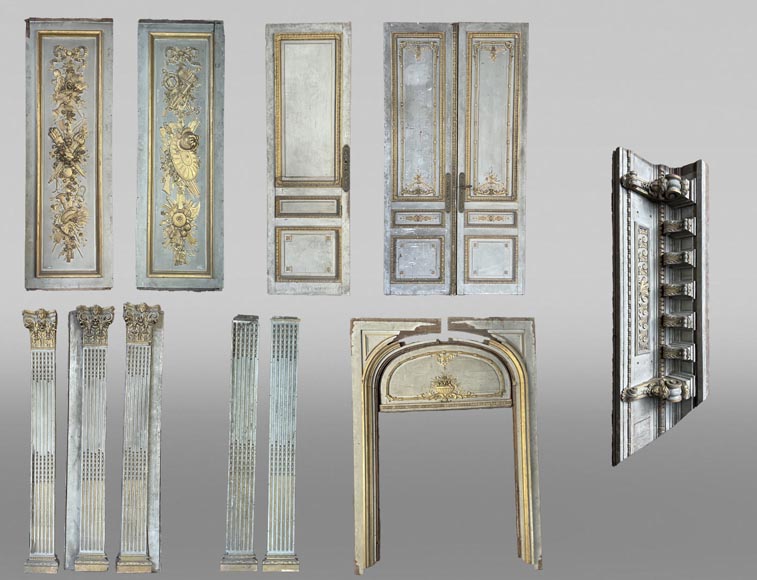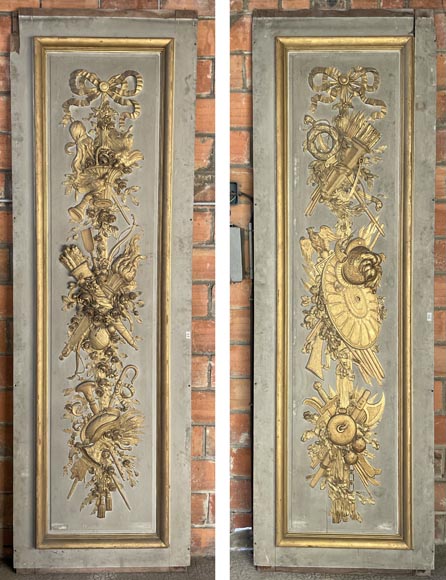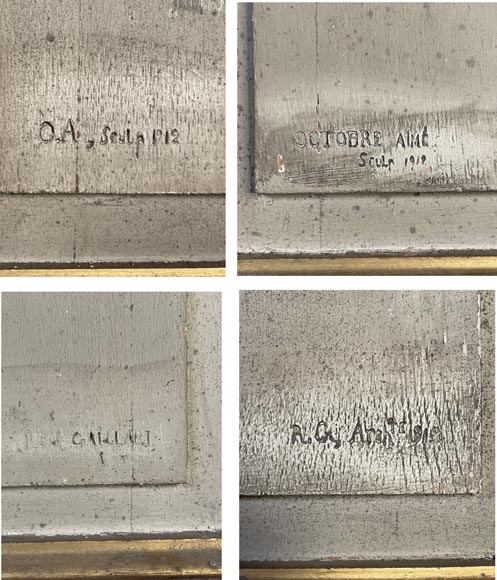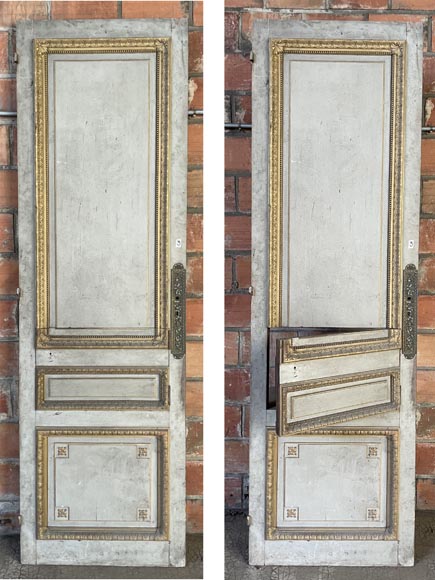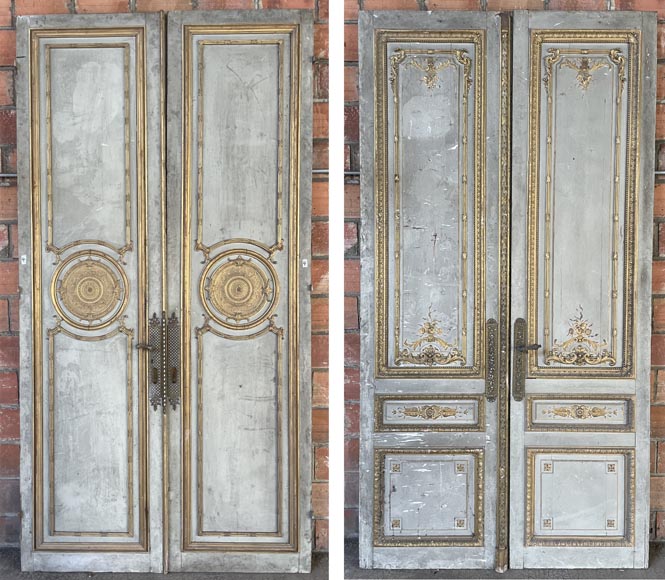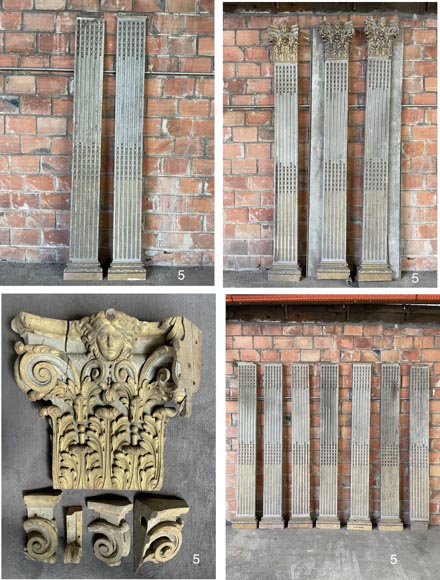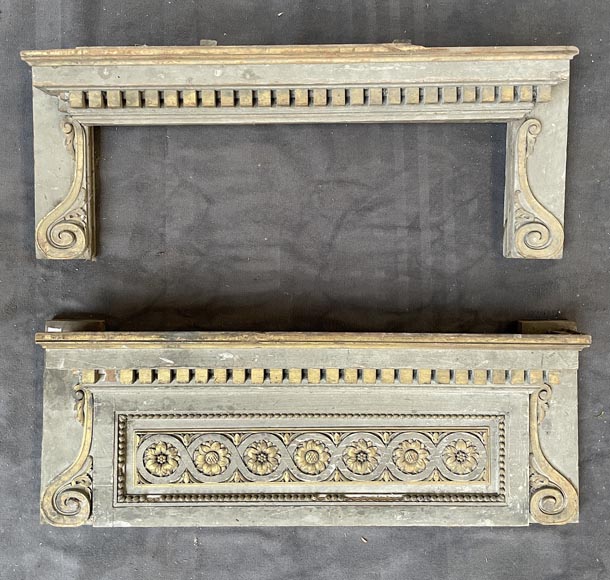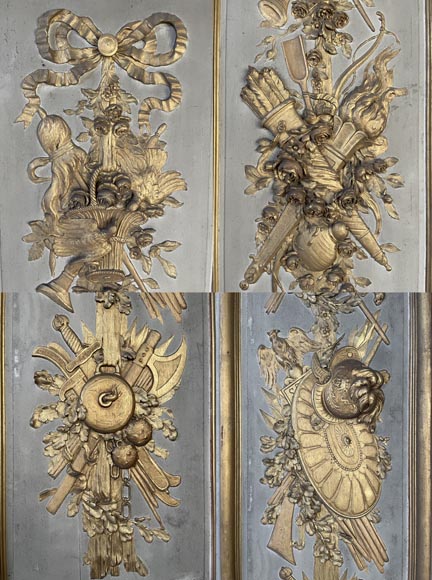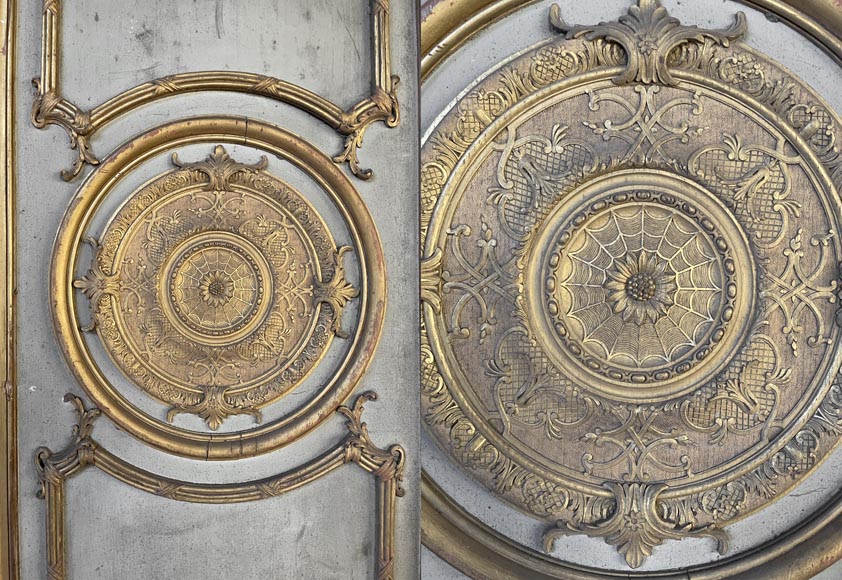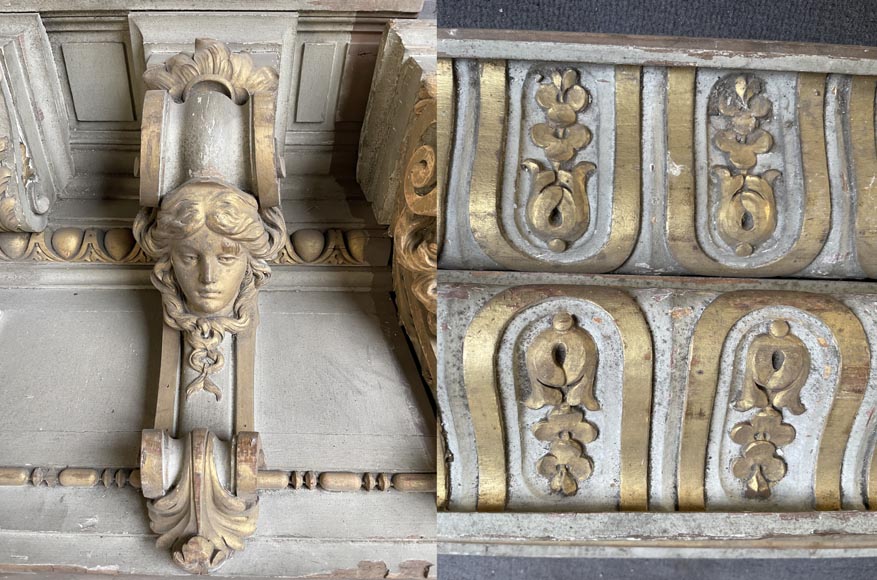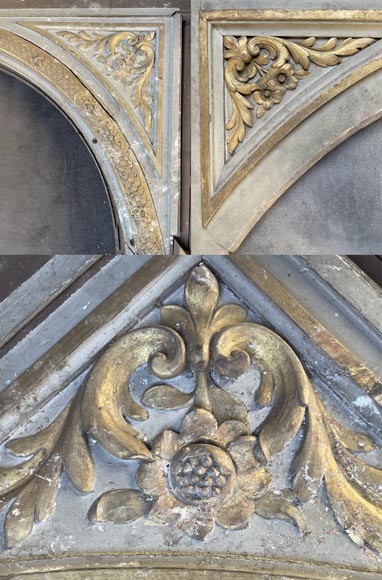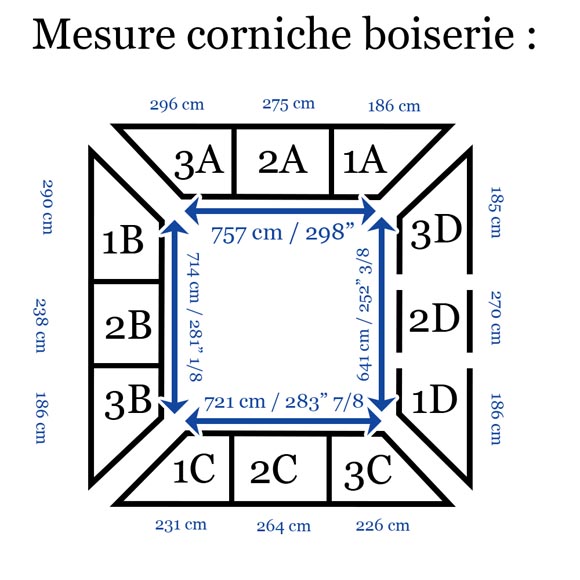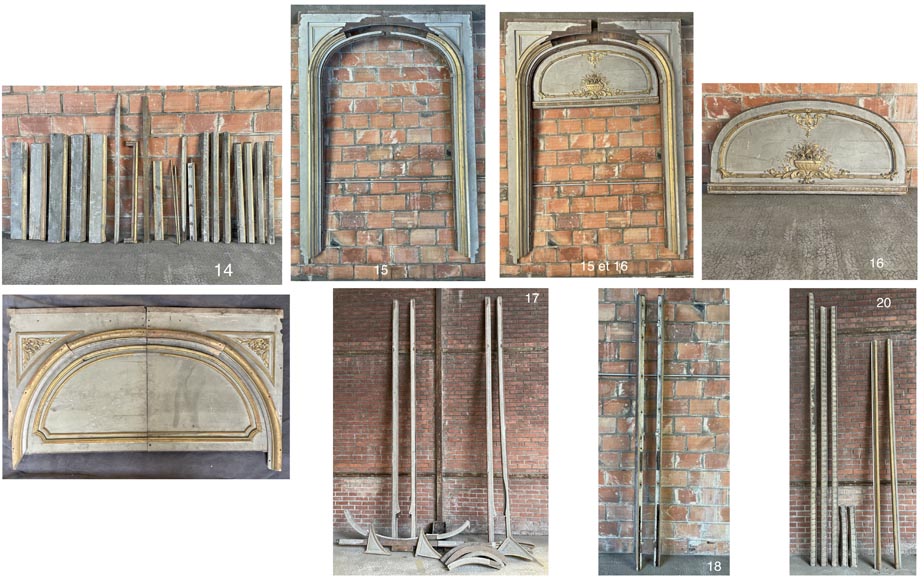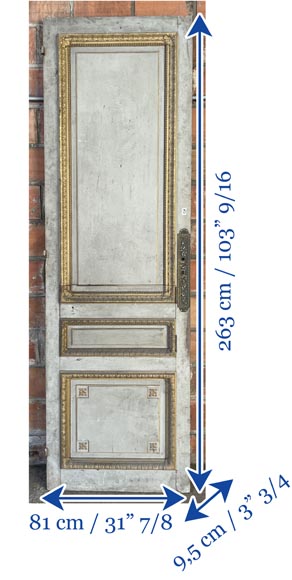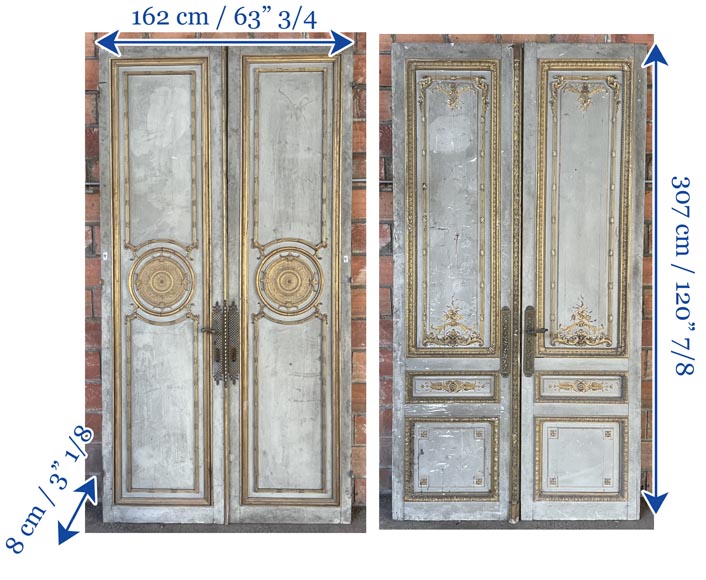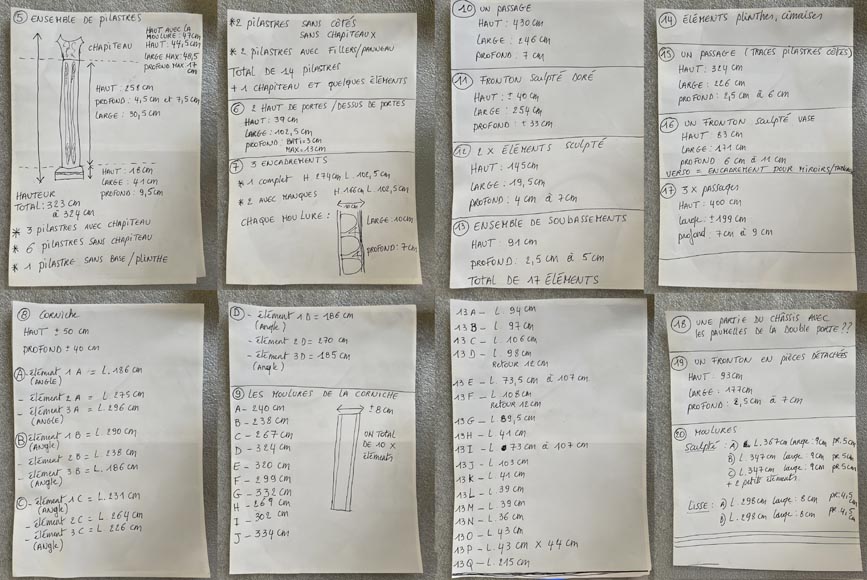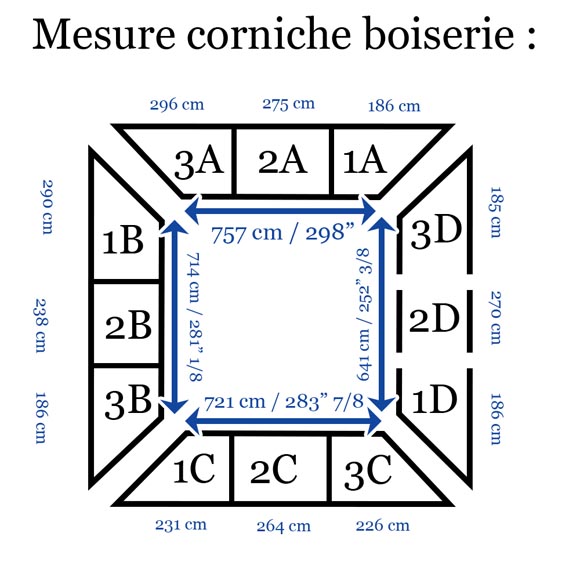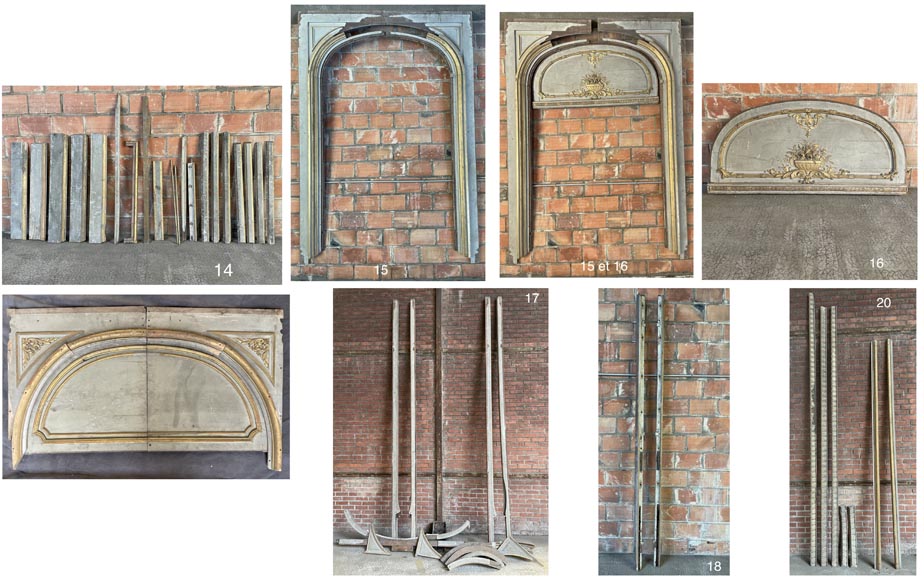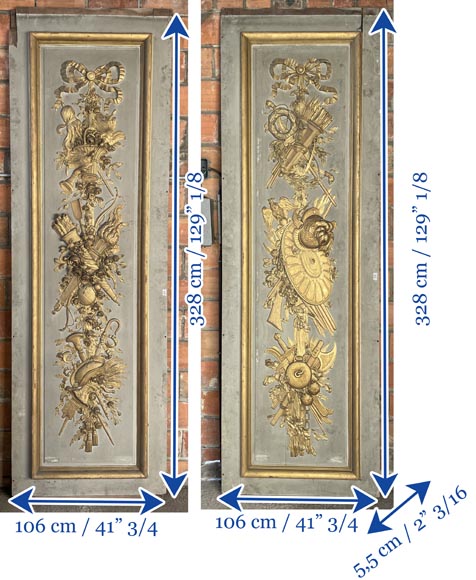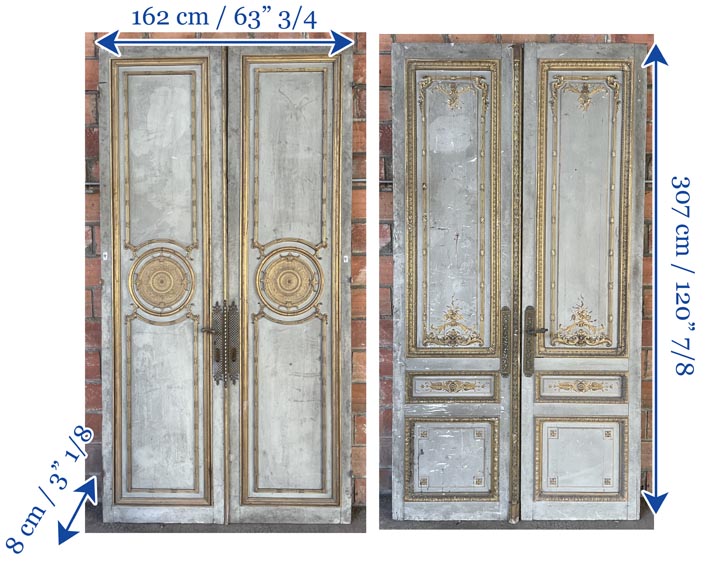Style Regence / Ref.14927
René Gaillard (architect), Aimé Octobre (sculptor), Regency-Style Painted and Gilded Woodwork, 1919
Dimensions
This extraordinary Régence-style woodwork was designed by René Gaillard and Aimé Octobre, and is dated 1919. It comes from a room that would have measured around 52 m², based on measurements given by the cornice elements.
The woodwork includes:
- A set of wainscot elements
- 14 pilasters (with or without capitals)
- 1 single door with pass-through
- 1 double door
- 2 overdoors
- 5 openings (with a sculpted low-relief reduction)
- 3 frames (2 of which are incomplete)
- 2 signed sculpted panels (one with the artists’ full names, the other with their initials)
- 1 gilded sculpted pediment + 1 pediment in detached pieces
- 1 molded cornice
- Plinth and cornice elements
- Molding
- 2 sculpted oak leaf elements
The woodwork was designed by architect René Gaillard and sculpted by Aimé Octobre.
René Gaillard (1872-1951) was a pupil and collaborator of his father Ferdinand, also an architect. Upon graduating from the École des Beaux-Arts in Paris in 1904, he succeeded his father. His achievements include the Peruvian pavilion at the 1900 Paris Exposition, for which he was awarded a silver medal, and the elegant façade of 14 Boulevard de Courcelles in the 17th arrondissement of Paris, whose windows are adorned with sculpted cherubs.
Aimé Octobre (1868-1943) studied at the École des Beaux-Arts under Jules Cavelier, then Jules Coutan. He won the Premier Grand Prix de Rome in 1893 and received several medals at the Salons of 1897, 1899, and 1931, as well as a silver medal at the 1900 Paris Exposition. He was named a Knight of the Legion of Honor in 1906 and promoted to Officer in 1925.
The entire set, with its exceptional quality of sculpture and execution, exemplifies the Régence style, which flourished between roughly 1715 and 1723. It represents a transitional period between the art of Louis XIV’s reign, then considered rigid and cold but already relaxing from 1700, and Louis XV’s reign, which saw the rise of Rococo art. Classic Louis XIV motifs (ovolo friezes, masks, wreaths, militaria…) alternate with softened curved elements, especially in the passageway details, such as the acanthus-adorned post frieze. This woodwork, crafted by exceptional artists, is extremely decorative and promises beautiful harmony once reassembled.
Below the wainscot elements, the woodwork walls are punctuated by pilasters with gilded sculptural ornamentation. Their base is topped with a laurel leaf torus and a ova frieze; the flutes are adorned with bundles ending in pendant flowers, echoed at the upper part. The pilasters are crowned with composite capitals, or rather in the French style, imitating those of the Hall of Mirrors at Versailles, topped with an Apollo head, a motif almost identically reproduced here.
The single door features a camouflaged opening that could serve as a pass-through. It is decorated with an ova frieze at the bottom, then with a molding bordered by water leaf and pearl friezes, and finally with a frame decorated with acanthus leaves and pearls. The plate accentuating the lock is a high, openwork cartouche featuring leaf motifs in the center and Greek waves along the border. The reverse of the door is much simpler, indicating it opened to the service areas on this side.
The double door is richly decorated on both sides. On one face, the doors are simply molded outwardly, adorned with bundles accented by an acanthus leaf in the corners. In the center, a disc displays acanthus leaves, interlacing, and a flower in a radiating motif. The handle is again enhanced by two openwork plates with a cross-hatched floral element, even covering the joint between the doors with a metal interlacing for greater harmony. On the other side, the same ornamental motifs are repeated for the frame; however, the central cartouche includes an additional vegetal element, while the upper frame contains delicate sculpted floral and vegetal ornaments at the top and bottom. The joint between the doors is this time fully concealed by a laurel leaf torus.
The two overdoors complement the doors’ decoration. Each is framed by two scrolls. One includes an inner panel bordered by a pearl frieze, within which two different blooming flowers alternate amid interlacing; the spandrels are also decorated with floral motifs. A modillion frieze crowns both pieces of woodwork.
Beyond the doors, the woodwork includes five distinct openings. One resembles a mirror: it fits within a rectangular space but has rounded corners, topped with leafy spandrels. Another is similarly shaped but less decorated. A third, more simply molded, forms an arched frame with another sculpted woodwork element adapting to the arc’s shape: a laurel leaf torus on the lower part, a bundle frieze with the same shape as a frame, interrupted only by a leafy motif supporting a flower-filled cup and an acanthus leaf palmette. A fourth resembles the previous one, but the arch’s interior is simply molded.
The woodwork also includes three framed pieces with gilded ovolo friezes.
It also features two sculpted panels of trophies: the first panel, signed with the full names of the artists, is adorned with three successive trophies. The first intertwines an oboe and a distaff behind a basket of roses, pecked by two doves; the second includes a quiver and torch entwined with roses, evoking the flame of love; the third is more pastoral: again an oboe, a shepherd’s staff, a sickle, a straw hat, and a cornucopia complete a sheaf of wheat.
The second panel presents more martial trophies: the first includes a bow with lion-head ends, arrows accompanied by a quiver, and a laurel crown, the victor’s insignia in ancient Rome; the second displays an eagle-shaped insignia with the inscription “SPQR”, another nod to Roman times, with a feather-plumed helmet sculpted with a gorgon head in bas-relief and a round shield surrounded by oak leaves; the third trophy combines various swords, an axe, and a flail.
A sculpted pediment enriches the woodwork’s decoration. It echoes the martial theme of this second sculpted panel: at its center, an imposing plumed helmet rests on a quiver filled with arrows, a sword, a carved leather piece bearing the inscription “SPQR,” bundles of fasces, and a ram’s head trophy, all set on a bed of oak leaves and flags.
The woodwork’s cornice is truly exceptional. Executed to an extraordinary standard, it fits perfectly within the Régence style of the woodwork. Its lower section features a rosary frieze, followed by an inner frame with two friezes of posts adorned with acanthus leaves, facing a palmette, and finally an ovolo frieze transitioning to the overhanging elements. Coffered sections alternate with ornamental scrolls; some, vertical, are larger and hold a mask reminiscent of those on the pilaster capitals, while the others are simple horizontal scrolls decorated with acanthus leaves. The alternation of large and small scrolls varies depending on the location.
The woodwork also includes numerous sculpted elements, plinths, and cornices, molding, etc.
Informations
Price: on request
Recommended for you :
Dimensions:
Width: 868
Height: 351
Depth: 522
Dimensions:
Width: 65
Height: 186
Depth: 5
Dimensions:
Width: 550
Height: 229
Depth: 480
Dimensions:
Width: 1200
Height: 291
Depth: 380
Dimensions:
Width: 595
Height: 275
Depth: 313
Dimensions:
Width: 597
Height: 314
Depth: 481
Dimensions:
Width: 566
Height: 298
Dimensions:
Width: 1860
Height: 170
Depth: 11
Dimensions:
Width: 631
Height: 370
Depth: 340
Dimensions:
Width: 447
Height: 340
Depth: 410
Dimensions:
Width: 367
Height: 245
Depth: 49



